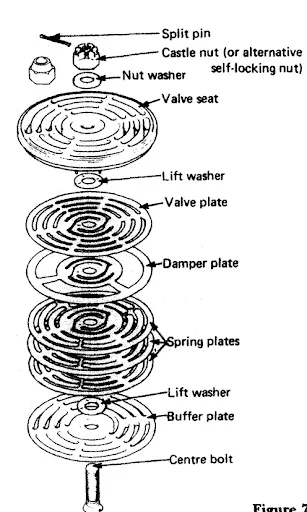A water jacket safety valve prevents a build-up of pressure should a cooler tube burst and compressed air escape. Relief valves are fitted to the first and second-stage air outlets and are designed to lift at 10% excess pressure. A fusible plug is fitted after the second-stage cooler to limit the delivered air temperature and thus protect the compressed-air reservoirs and pipework.
Cooler drain valves are fitted to compressors. When these are open the machine is 'unloaded' and does not produce compressed air. A compressor when started must always be in the unloaded condition. This reduces the starting torque for the machine and clears out any accumulated moisture in the system.
This moisture can affect lubrication and may produce oil/water emulsions which line the air pipelines and could lead to fires or explosions. The compressor motor is started and the machine runs up to speed. The lubricating oil pressure should be observed to build up to the correct value.
Must read ➤ System Of Piping
The first-stage drains and then the second-stage drains are closed and the machine will begin to operate. The pressure gauge cocks should be adjusted to give a steady reading. Where manual drains are fitted they should be slightly opened to discharge any moisture which may collect in the coolers.
The cooling water supply should be checked, and also the operating temperatures, after a period of running loaded. To stop the compressor, the first and second-stage cooler drain valves should be opened and the machine run unloaded for two to three minutes. This unloaded running will clear the coolers of condensate.
The compressor can now be stopped and the drains should be left open. The cooling water should be isolated if the machine is to be stopped for a long period. Automatic compressor operation is quite usual and involves certain additional equipment.
An unloader must be fitted to ensure the machine starts unloading, and once running at speed will load' and begin to produce compressed air. Various methods of unloading can be used but marine designs favour either depressors which hold the suction valve plates on their seats or a bypass which discharges to suction.
Automatic drains must also be fitted to ensure the removal of moisture from the stage coolers. A non-return valve is usually fitted as close as possible to the discharge valve on a compressor to prevent return air flow: it is an essential fitting where unloaders are used. Control or instrument air supplies have particular requirements about being moisture and oil-free and without impurities.
Automatic valve
A special type of oil-free compressor may be used to supply control air or it may be treated after delivery from an ordinary air compressor. This treatment results in the air being filtered and dried to remove virtually all traces of oil, moisture and any atmospheric impurities. Maintenance involves the usual checks and overhauls common to reciprocating machinery,
e.g. crankcase oil level, cooling water system, operating temperatures and pressures, etc. The suction and delivery air valves for each stage will present the most work in any maintenance schedule. These valves are automatic, requiring a small pressure differential to operate. The constant rapid opening and closing action of the valves may require the seats to be refaced.
Overheating, use of incorrect lubricating oil, or the presence of dirt may result in sticking or pitting of the surfaces. The various buffer plates, spring plates, valve plates and seats make up a suction or delivery valve.
The valves should be stripped and all parts carefully cleaned and examined, any worn parts replaced and the valve seat and plate lightly lapped separately on a flat surface before reassembly to ensure a good seal.


Post a Comment